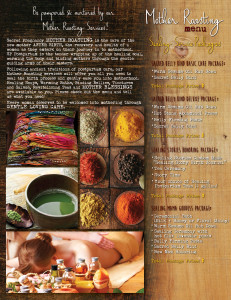 I was certified as Sacred Postpartum Belly Binder, with Sacred Pregnancy a few years ago making me one of the first in Florida . Belly Binding is an effective and important part of a mama’s recovery that aids the body to shrink and recover in shorter time period, normally six to eight weeks. A sacred belly wrap provides a mama’s postpartum body with 360 support to assist the abdominal wall muscle retraction, improve posture, stabilize loosened ligaments, and provide support to the torso while vital organs returned to their pre-pregnancy size and position. Your posture matters a lot after you have just delivered a baby. Our body goes through a lot of changes and you need to make sure that your body posture is fixed, to learn how you can get your body posture fixed you can check out The 5 Best Posture Corrector Braces Reviews.
I was certified as Sacred Postpartum Belly Binder, with Sacred Pregnancy a few years ago making me one of the first in Florida . Belly Binding is an effective and important part of a mama’s recovery that aids the body to shrink and recover in shorter time period, normally six to eight weeks. A sacred belly wrap provides a mama’s postpartum body with 360 support to assist the abdominal wall muscle retraction, improve posture, stabilize loosened ligaments, and provide support to the torso while vital organs returned to their pre-pregnancy size and position. Your posture matters a lot after you have just delivered a baby. Our body goes through a lot of changes and you need to make sure that your body posture is fixed, to learn how you can get your body posture fixed you can check out The 5 Best Posture Corrector Braces Reviews.
During pregnancy a mama’s body retains water, fat, and air which cause her body to swell and expand, including the organs in the womb area such as the cervix and vagina. The water retained by cells supported the amniotic fluid; and the purpose of the air was to cushion the baby, a mama’s internal organs and bones, as her center of gravity shifted and the baby grew larger and larger. This is why a mama gets more and more swollen during the last months of pregnancy. When a baby is born the excess water, fat and flatulence are no longer needed and the cells will naturally release and shrink back to their pre-pregnant size. However, the purpose of a post-pregnancy wrap is to speed up this process with constant pressure on the abdomen and torso area.
A longer design of a post-pregnancy wrap (unlike the short velcro ones ) provides a holistic support to all of the abdominal and pelvic organs, including the muscles, in the pelvic area. Support to the pelvic area is very important in the immediate weeks after birth as a mama’s cervix dilates 10 cm when active labor is reached; this is equivalent to the size of an average bagel. Therefore the pressure of a longer wrap on the hip area helps the cervix shrink and allows the pelvic muscles to heal without being further stretched.Steady, pressured support on the hips allows the body to “close” more easily than if just left in its expanded state. The bengkung style of binding, based in Malaysia, is known to help heal diastasis recti with the constant supportive pressure on the abdomen area.
During pregnancy, musculoskeletal changes are stimulated by hormone secretions and the continuous expansion of the uterus. Some of these changes include:
- Abdominal wall expansion and abdominal wall separation (Diastasis recti)
- The growing fetus and the increasing weight of the baby puts pressure on the muscles can stretch the abdomen as much as 50%.
- The abdominal muscles (rectus abdominis) on either side are joined by a narrow fibrous strip (linea alba) that thins as it stretches. Hormonal changes which happen during pregnancy also cause connective tissue to soften.
- When the muscles separate, their strength is reduced and this can lead to back pain. The condition is more likely to occur where the abdominal muscles were weak prior to pregnancy. It is vital that the abdominal wall returns to its pre-pregnancy location to protect internal organs and properly support the torso.
Spine and Posture Realignment
Posture is greatly affected as a baby grows larger in the womb. The pelvis tips forward to counterbalance the baby’s weight, which causes the pubic bones and tailbone to move backward, increasing the arch in the lower spine and creating a lordotic posture upper spine simultaneously responds to this structural change by increasing its curvature, which rounds the shoulders forward, collapses the chest inward, and slides the head forward, creating a kyphotic posture. The combination of the kyphotic/lordotic posture results in the classic “S” shaped spine of a pregnant woman and is a direct result of a shifting centre of gravity. This shifting of a woman’s center of gravity and spine can affect the nervous system and cause aching, weakness, and numbness in the body.
Pelvic floor relaxation
The pelvic floor provides balance, body stabilization, and vital organ support. The pelvic floor is the base of the core muscle system, attaching to the abdominal muscles and the sacroiliac joints. During pregnancy, hormones cause ligaments to stretch, which loosens the pelvic floor structure. This natural realignment allows the pelvic bones to open for the baby’s birth and makes a mama feel a bit wobbly on her feet. After birth the pelvic floor can remain loose and unstable for up to five months. Because the pelvic floor acts as the support
system for the lower intestine, colon, and bladder, these vital organs may be less supported for a few months immediately postpartum. This lack of organ support is the primary reason why women
suffer incontinence when coughing, sneezing, or laughing after giving birth.
**Cesarean incision support
C-section mamas should wait 6 weeks until their incision is mostly healed before being wrapped.
For the best results
Begin tummy binding as soon as you can after giving birth, ideally around Day 3, and then continue to wear it each day for at least 40 days and even longer if you are not satisfied with your healing.
The wrap should be on for 10-12 hours a day in the very beginning if possible.
When I am hired to do your Sacred Postpartum Belly Bind as a service, I go out and bind mama every other day for at least 3 times, I apply a special warming herbal paste and then show daddy or another support person how to do it in order to continue the practice of binding for her. I also offer a herbal milk bath prior to the binding.
Please call me to inquire about the various Postpartum services packages I offer.


.png)